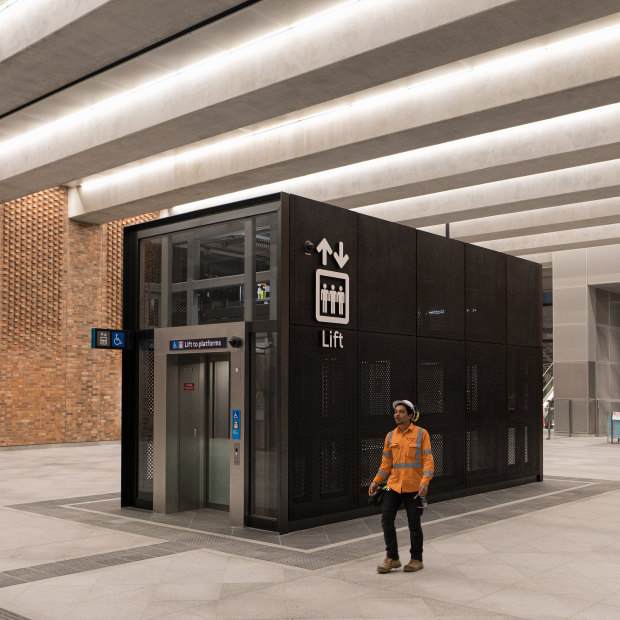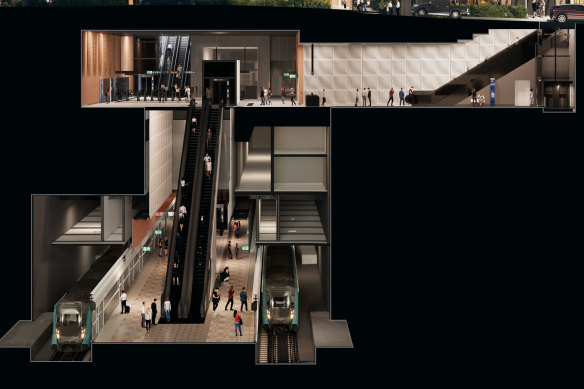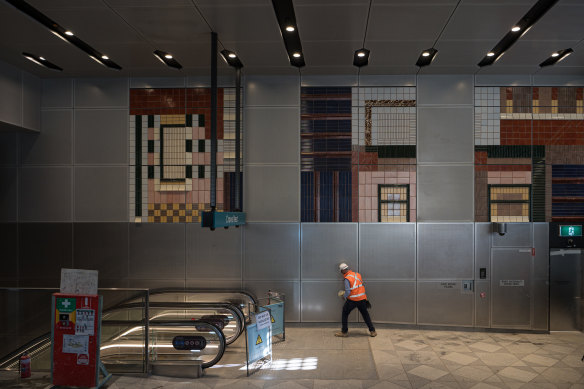This was published 11 months ago
What became the greatest threat to this new Sydney metro train station

The underground concourse at Crows Nest station links platforms beneath to the two entrances at street level. Credit: Flavio Brancaleone
No sooner had workers pumped water out of a vast hole for a metro train station at Crows Nest on Sydney’s north shore in 2021 than thunderstorms dumped more. The unrelenting rain repeatedly delayed the pouring of concrete and other construction, causing headaches for project bosses who had to ensure a tight schedule was met for the opening this year of a mega rail line.
“We were getting 50mm [and] 100mm rainfall events – really intense thunderstorms. We had no time to recover,” Sydney Metro City and Southwest project director Hugh Lawson recalls. “You were never fully able to dry the station out.”
Within a fortnight, commuters are due to start filing into the new Crows Nest station, which forms part of the city-section of the $21.6 billion line between Chatswood and Sydenham. Yet, many will be unaware of the challenges that construction workers had to overcome to build it.

A render shows a side-on view of the underground Crows Nest station.Credit: Sydney Metro
Wedged next to the busy Pacific Highway, the station’s location was difficult for trucks to access to offload building materials. Eventually, transport officials closed a lane to create a layby for trucks.
In fact, Lawson says Crows Nest was one of the most challenging to build because of the narrow, constrained site. “They’re all difficult children,” he says of the six new metro stations along the line. “From an engineering perspective, this was probably one of the most challenging. The structural design was really hard here.”
Its design meant a massive crane, which extended deep into the bowels of the station, had to remain in place for much longer than at other sites along the mostly underground line between Chatswood and Sydenham. It left the station exposed to the weather until it was removed.
“Until you have taken [the crane] out you’ve basically got a hole at every level,” Lawson says. “Water could get all the way down to platform level. It was a constant effort distracting [contractors] from actually building.”
About 10 minutes’ walk from St Leonards station, the new metro station’s red-brick exterior at Crows Nest is eye-catching. About 126,000 bricks were laid by hand, creating a patchwork which took a year to complete.
Artwork on walls at the two entrances featuring ceramic tiles by international exhibitor Esther Stewart will greet commuters before they descend on escalators or lifts to the main underground concourse. A large brick wall in the concourse and massive pre-cast beams in the ceiling are striking.
Commuters will then take another two banks of escalators or lifts down to the train platforms, which are about 35 metres below the surface. While they will traverse two underground levels, the station is much bigger: rooms for giant fans, communications, electrical switches and signalling equipment are hidden from view.
Heavily reinforced concrete walls are more than a metre thick. Structural beams and steel trusses above channel the load from the building above into the walls, creating a large open space absent of columns. In comparison, Sydney’s existing stations at Town Hall and Martin Place are dotted with columns on their platforms to support the buildings above.
“There are loads of super heavy engineering to create this,” Lawson explains, pointing at the large underground concourse. “This is a huge open space 20-odd metres wide. You’re not going to come down in here and feel like you’re in some cramped underground space. It’s light and airy.”
The 120-tonne steel trusses were prefabricated in Newcastle, and had to be trucked to the site. “If you went to build them on the site, you wouldn’t have had the room,” says Rauiri McAllister, construction manager for station builder AW Edwards. “This is a large, long skinny project.”
While the six new stations on the metro line have the same platform screen doors, help points, toilets and information displays, Lawson says they wanted each one to stand apart from the others.
“These are not cookie cutter stations. You’re not turning up at the station and kind of wondering, ‘which one am I at’?” he says.
“The aim is that you get off the train, and you know immediately you’re at Crows Nest because it’s quite different to Victoria Cross [at North Sydney]. That’s deliberate – they are meant to look different.”
Lawson says there is a wide range of architecture and artwork installed in the six new stations. “Not everyone is going to like everything. People have different opinions and views. Some will like this [at Crows Nest] more than others. Some will like what’s at Barangaroo or Victoria Cross more,” he says.
Crows Nest station delivery director Matt Deeks, who was involved in building London’s £19 billion Elizabeth line, says brick was chosen as a key feature because architects wanted it to blend into the surrounding area, which has many heritage-listed buildings with brickwork facades.
In a further nod to the area’s history, rusted panels above screen doors on the platforms are among the station’s unique features.
Transport Minister Jo Haylen says Crows Nest is not just a beautiful station that will help passengers travel under the harbour to the CBD in less than five minutes. “The housing and commercial space it delivers will provide a big boost to the surrounding community, too,” she says.

Artwork adorns the walls of entrances to Crows Nest metro station.Credit: Flavio Brancaleone
An over-station development will consist of an eight-storey commercial building overseen by Sydney Metro, as well as a 21-storey office tower and 17-storey apartment building. The initial eight-storey building was part of the station-build contract with AW Edwards because it would not have been able to have been constructed later without closing the new station.
“The station is effectively the foundations for those buildings. It’s all been designed and built already ... to take all those loads,” Lawson explains.
Start the day with a summary of the day’s most important and interesting stories, analysis and insights. Sign up for our Morning Edition newsletter.